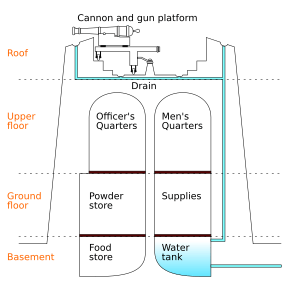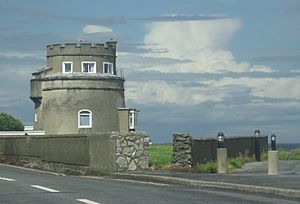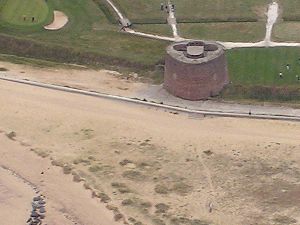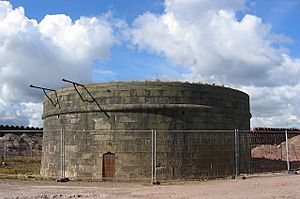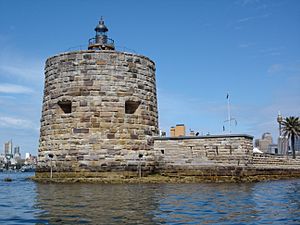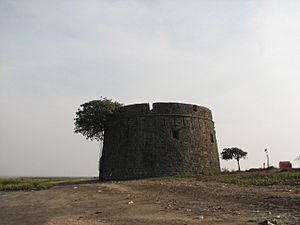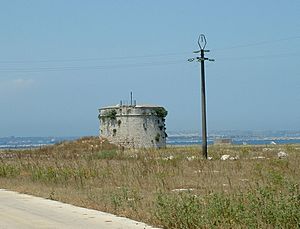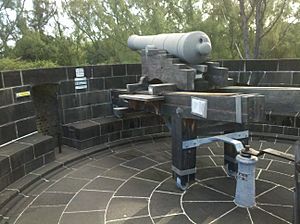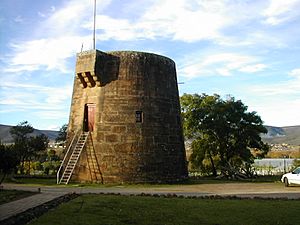Martello tower facts for kids
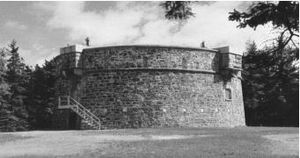
Martello towers are small, strong forts. They were built by the British Empire in the 1800s, starting during the French Revolutionary Wars. Most of these towers were used to defend coastlines.
These towers are about 12 meters (40 feet) tall and have two floors. They usually had a small group of soldiers, like one officer and 15 to 25 men. Their round shape and very thick stone walls made them tough against cannon fire. Being tall, they were perfect for holding a single, large cannon on the flat roof. This cannon could turn all the way around (360 degrees) to shoot in any direction. Some towers even had moats or extra defenses.
Martello towers were important in the early 1800s. But they became old-fashioned when new, more powerful cannons were invented. Many towers still stand today and are protected as historical sites. Later in the 1800s, more forts were built that looked like Martello towers. These are known as the Palmerston Forts.
Contents
How Martello Towers Started

Martello towers were inspired by a round fort in Corsica. This fort was part of a bigger defense system built by the Genoese people. It was located at a place called Mortella Point, which means "Myrtle" Point. The fort was finished in 1565.
For a long time, Corsicans had built similar towers around their island. These towers protected villages and ships from North African pirates. The towers were one or two stories high and about 3.5 to 4.5 meters (12 to 15 feet) wide. They had a single door about 5 meters (10 feet) off the ground. People could only get in using a ladder, which they would pull up after themselves.
Local villagers paid for these towers and for the watchmen. These watchmen, called torregiani, would light a fire on the tower roof to warn of approaching ships. This fire would alert local defenders. Even after the pirate threat lessened, new round towers were built to protect against other invaders.

In 1794, two British warships tried to attack the Mortella Point tower. They fired at it for two and a half hours but couldn't damage it much. The tower finally fell to land forces after two days of tough fighting. The British were impressed by how well the tower defended itself. Its walls were incredibly thick. Even after being shot at for two days, the defenders held out until hot cannonballs set fire to some materials inside.
The British decided to copy this strong design. But they accidentally misspelled "Mortella" as "Martello." "Martello" means "hammer" in Italian. When the British left Corsica in 1803, they blew up the original tower to make sure it couldn't be used again.
How Martello Towers Were Built

Martello towers were about 12 meters (40 feet) tall. Their walls were around 2.4 meters (8 feet) thick. In some towers, the rooms were built closer to the land side. This made the walls thicker on the side facing the sea, where attacks were more likely.
To get inside, people used a ladder to reach a door about 3 meters (10 feet) up from the ground. Above the door was a special platform with slots. This allowed defenders to shoot downwards at anyone trying to get in. The flat roof had a high wall around it and a raised platform in the middle. A cannon was placed here on a pivot, so it could turn 360 degrees. Some towers had more than one gun, but each had a smaller area it could shoot at. The walls also had narrow slits for soldiers to fire muskets through.
A typical British Martello tower had two floors, and sometimes a basement. The ground floor was used for storing things like ammunition, water, and food. The soldiers, usually 24 men and one officer, lived on the first floor. This floor was divided into several rooms. There were fireplaces for cooking and keeping warm. The officer and the soldiers had separate rooms. A well or a water tank inside the fort provided water. A system on the roof collected rainwater to refill the tank.
Martello Towers Around the World
In the early 1800s, the British government built many Martello towers. They built about 140 towers along the coasts of Britain and Ireland. Most of these were along the south coast of England. Other countries like Australia, Canada, Menorca, South Africa, and Sri Lanka also built them. Building Martello towers continued until the 1870s. But then they stopped because new, powerful cannons could easily destroy them.
The French also built similar towers on their coast. They used these towers to send messages using optical telegraphs. The United States also built some Martello towers along its east coast. These towers copied the British design but had some changes.
United Kingdom
Great Britain and Ireland were one country, the United Kingdom of Great Britain and Ireland, from 1801 to 1922. This was when most Martello towers were built. So, the towers in Britain and Ireland were part of one big defense plan. This plan protected the coastlines of both islands.
You can see this clearly on the south and east coasts of England and the east coast of Ireland. Here, many Martello towers were built in a line. In other parts of the world, single towers were built to protect important places.
England
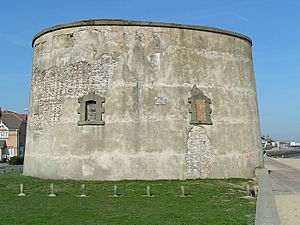
Between 1804 and 1812, the British built a long line of towers. These were based on the original Mortella tower. They were meant to defend the south and east coasts of England, Ireland, Jersey, and Guernsey. This was to protect against a possible invasion from France, led by Napoleon. In total, 103 Martello towers were built in England. They were placed at regular distances along the coast from Seaford to Aldeburgh.
Three much larger round forts were also built at Harwich, Dymchurch, and Eastbourne. These acted as supply centers for the smaller towers and were strong forts themselves.
Britain's Martello towers were never attacked by Napoleon's invasion fleet. However, they were good at stopping smuggling. After the threat of invasion passed, many towers were used by the Her Majesty's Coastguard to fight smuggling.
Some towers were taken down to reuse their stones. The sea washed away 30 towers. Four towers were destroyed in tests to see how well they stood up to new cannons. During World War II, some Martello towers were used again by the military. They became places to watch for enemies and to hold anti-aircraft guns.
Today, 47 Martello towers still stand in England. A few have been fixed up and turned into museums, visitor centers, or art galleries. Some are owned by private people or are homes. The rest are empty and falling apart. Many of the remaining Martello Towers are now protected as Listed Buildings.
Scotland
Three Martello towers were built in Scotland. The first was built in 1807–09 on rocks facing the Firth of Forth. It was meant to defend Leith Harbour. This tower, called the Tally Toor, is now on land within the eastern breakwater.
Two more towers were built near Longhope in Orkney between 1813 and 1815. They protected against French and American raiders attacking ships. One of these, the Hackness tower, is now a museum run by Historic Scotland.
Wales
A few Martello towers were built in Wales, but not many are left. The most famous ones are in Pembroke Dock. They were built between 1848 and 1857 to protect the naval base there. One tower is now privately owned. The other is by the river, near the old naval base entrance. It was a small museum about local history and defenses, but it has closed due to water damage.
Ireland
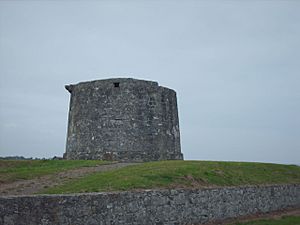
About 50 Martello towers were built around the Irish coastline. Many were along the east coast, especially around Dublin Bay. Twenty-six towers around Dublin Bay were built so they could see each other. This allowed them to communicate and warn of attacks.
One of the most famous towers is in Sandycove, near Dún Laoghaire. The writer James Joyce lived there for a few days. This tower is now called the James Joyce Tower and Museum and has a museum about him. Other towers are nearby at Bullock Harbour, Dalkey Island, and Seapoint.
Martello Tower South No.7, on Tara Hill, Killiney Bay, is special. It has been fully restored. It even has a working 18-pounder cannon on its roof that can turn around. There is also a three-gun battery below the tower.
On the north side of Dublin, you can find Martello towers in Balbriggan, Shenick Island, and Skerries. There are also towers in Rush, Portrane, Donabate, Malahide, Portmarnock, Ireland's Eye, Howth, and Sutton.
There were seven Martello towers around Cork Harbour. Five of them still exist. One tower, the Monning Martello tower, was briefly captured during the 19th-century Fenian Rising. This is believed to be the only Martello tower ever captured, apart from the original one.
The British built two Martello towers on the Hook Peninsula. These protected the fort near Duncannon and the entrance to Waterford Harbour. A third tower is at Baginbun Bay.
One interesting tower is the Meelick Martello Tower in County Offaly. It guards a crossing of the River Shannon. This tower is shaped like a cam and can hold three guns, unlike most Martello towers that are round and hold only one.
The tower at Seapoint, County Dublin, was once a boat club and then a history society office. The restored tower at Ilnacullin is part of a beautiful island garden. Other towers still exist in Rathmullan and County Clare. There is also a restored Martello tower at Magilligan Point in County Londonderry.
A tower on Achill Island is known as the "French Tower" or "Napoleonic Tower." It's square, not round, and was likely used for signaling.
Other Countries
Australia
The last Martello tower built by the British Empire is said to be part of Fort Denison in Sydney Harbour, New South Wales. It's the only Martello tower in Australia. Building started in 1841 after two American warships entered Sydney Harbour at night. This made the government realize their defenses were not strong enough. Construction continued in 1855 because of a fear of Russian attack during the Crimean War. However, it was finished in 1857, after the war ended. Fort Denison is well kept and is now a popular place for tourists.
Bermuda
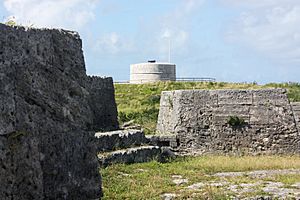
There is a Martello tower at Ferry Reach, Bermuda. It was built between 1822 and 1823 from Bermuda limestone. This tower shows how coastal forts changed over 30 years. An older fort nearby had many guns pointing one way. The Martello tower used one gun that could turn all around to cover the whole area.
It has an oval shape, with walls 2.7 to 3.3 meters (9 to 11 feet) thick. A dry moat surrounds it. The tower's job was to defend the Ferry Reach Channel. This would stop any attack on St. George's Island from the main island of Bermuda.
The tower was fixed up in 2008. An 18-pounder cannon was placed on top. You can visit the site.
Canada
Nine of the 14 Martello towers built in Canada are still standing. Canadian Martello towers often had removable cone-shaped roofs to protect against snow. Today, many restored towers have permanent roofs for easier care.
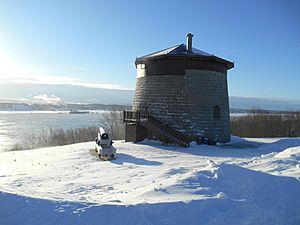
Quebec City originally had four Martello towers. Tower No. 1 is on the Plains of Abraham and overlooks the Saint Lawrence River. It is now a museum and you can visit it in the summer. Tower No. 2 is nearby and sometimes hosts special events. Tower No. 3 was taken down in 1904. Tower No. 4 is in a neighborhood and is not open to the public.
Halifax had five towers. The oldest, the Prince of Wales Tower in Point Pleasant Park, is the oldest Martello-style tower in North America. It was built in 1796 and is now a National Heritage site.
Four Martello towers were built at Kingston, Ontario. They defended the harbor and naval shipyards. Murney Tower and the tower at Point Frederick are now museums open in the summer. The Shoal Tower is the only one completely surrounded by water. Cathcart Tower is on Cedar Island and is not used.
The Carleton Martello Tower in Saint John, New Brunswick, is now a museum and a National Historic Site.
Guernsey
There are three similar Martello towers in Guernsey, all built in 1804: Fort Grey, Fort Hommet, and Fort Saumarez.
Older towers in Guernsey, called Guernsey loophole towers, are sometimes called Martello towers. But they were built earlier and are different. They are like earlier versions of the Martello tower.
India
A type of Martello tower existed in Punjab before the British arrived. There is a Martello Tower built by the Portuguese at the Arnala fort in India. It is the best surviving example of these towers. The British also built Martello towers at the British Residency in Hyderabad after the Indian Rebellion of 1857. These were later taken down. Another example, built in 1856 in Pakur, is still in good condition but needs care.
Italy
In the early 1800s, during British control of Sicily, towers were built to stop Napoleon's armies. Because ships' guns were more powerful, the Martello tower design was chosen.
Seven Sicilian Martello towers were built around 1810. Only four remain. These include the Mazzone Tower at Faro Point, Messina, and the Magnisi tower at Priolo Gargallo, Syracuse. The Italian Navy used the Magnisi tower as a lookout during World War II. The Cariddi tower at Ganzirri in Messina and a tower near the Castello Maniace in Syracuse also remain.
Jamaica
There is a Martello tower at what was Fort Nugent in Harbour View. It was built to protect the home of a Spanish slave agent. Later, an English Governor strengthened the fort to guard the eastern entrance of Kingston Harbour. The tower was likely built between 1808 and 1811.
Jersey
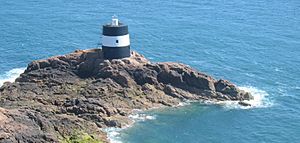
The British built eight true Martello towers in Jersey. Three were built between 1808 and 1814, and five between 1834 and 1837. One, L'Etacq, was destroyed by German forces during World War II. The three original towers are Icho Tower, Portelet Tower, and La Tour de Vinde. The four surviving later towers are Lewis Tower, Kempt Tower, La Collette Tower, and Victoria Tower.
There are also older towers in Jersey, called Jersey Round Towers. They are often called Martello towers but were built earlier and are different. They are like earlier versions of the Genoese towers.
Mauritius
The British built five Martello Towers in Mauritius between 1832 and 1835. Three of them still exist. One tower, Cunningham Tower, was part of Fort George at the entrance to Port Louis harbor. Two towers were built at Grand River North West. The other two were built at the mouth of the Black River.
One tower near the La Preneuse public beach has been restored. It is now a museum for visitors. The other tower in the Black River district still exists but has been neglected. The third existing tower is at Pointe aux Sables.
Sierra Leone
A Martello tower was built on Tower Hill in Freetown, Sierra Leone, in 1805. It defended the port from attacks. In 1870, it was changed to hold a water tank for Government House. The tower is now part of Sierra Leone's Parliament Buildings.
South Africa
The British built three Martello towers in South Africa. One is at the Simon's Town Naval base near Cape Town. Another was in Cape Town itself, but it was taken down over 100 years ago. The third was built at Fort Beaufort in 1837. It is probably the only Martello tower built inland, away from the coast.
Spain
During the British occupation of Menorca (1798–1802), about 12 Martello towers were built along the coast. With three Spanish towers already there, Menorca had 15 towers.
Five towers were built to protect Mahón. One tower, the Princess Tower, was later used as a powder magazine. It was destroyed in 1958 when lightning struck it.
Stuart's Tower was built in 1798 to protect the port of Mahón. Its name was later changed to Torre d´en Penjat, or Hangman's Tower.
To protect the harbor of Fornells, the British built a tower on the rocky headland. They also built a small tower on Sargantana island and two more nearby.
One tower was built at Santandria to protect the old capital of Ciutadella. The British also used three older Spanish towers. In 1808, a British landing party destroyed an unarmed tower at Punta Na Radona.
There are also four towers on the island of Formentera and one on nearby S'Empalmador.
Another tower was built by English troops in Cartagena during the Peninsular War. This tower is still in good condition and is used for telephone antennas.
Sri Lanka
Sri Lanka has one Martello tower at Hambantota on the south coast. It was restored in 1999. This tower might have helped fight off a French attack. British engineers started building three towers to protect Trincomalee, but they were never finished.
United States
The United States government built several Martello towers along its eastern coast. Two are at Key West, Florida. Others were built at the harbors of Portsmouth, New Hampshire, Charleston, South Carolina, and New York City. Two more stood at Tybee Island, Georgia and Bayou Dupre, Louisiana.
American Martello towers were different from British ones in some ways. The tower at Tybee Island, Georgia was built around 1815 using wood and a local material called tabby, not brick or stone. It also had gun loops for muskets. It was never used in battle and was falling apart by the time of the American Civil War.
The Key West towers are called Martellos by locals, but they are square, not round. They also have thin walls with long gun loops. A wall of heavy guns surrounded them, making them more like keeps than standalone towers.
A Martello tower is shown on the coat of arms of the 41st Infantry Regiment of the United States Army.
Images for kids
-
An offshore Martello tower on Shenick Island, County Dublin.
See also
 In Spanish: Martello (torre) para niños
In Spanish: Martello (torre) para niños


